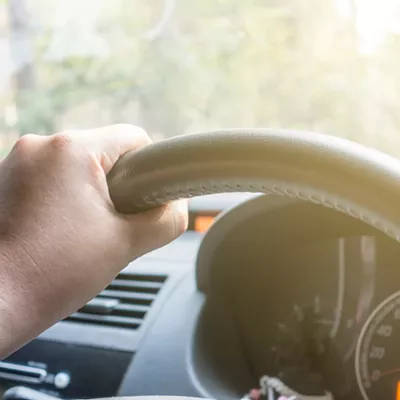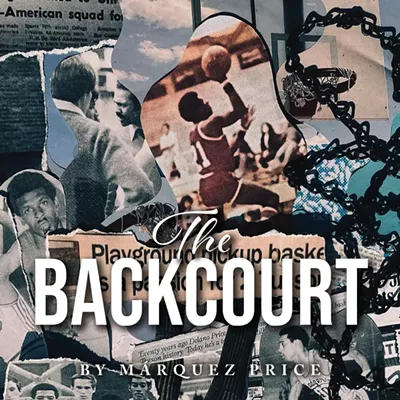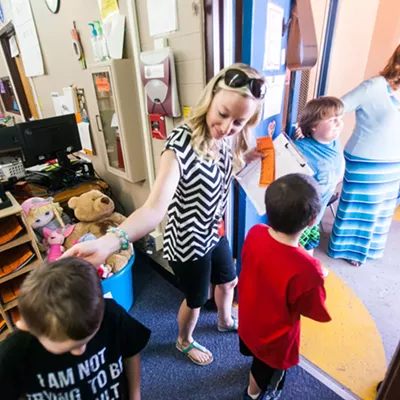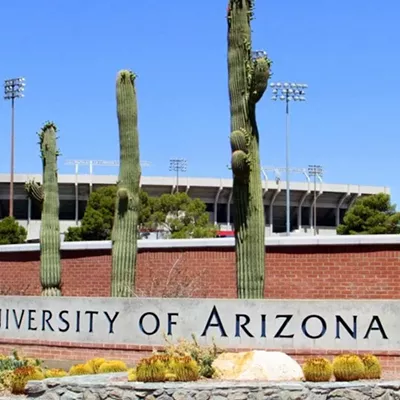Students stream toward the parking lot, flashing their IDs to monitors and then piling into cars to head off campus. As it is much of the time, Yavapai Road--which dead-ends as it enters the school grounds just west of Stone Avenue--is the only way to get on or off the campus. Drivers leaving the campus and approaching the light at Stone have three options: a left-turn lane that will take the students north toward the Tucson Mall; a right-turn lane that leads to fast-food places on Grant and Oracle; and a middle lane designed for vehicles that are heading east on Yavapai into the adjacent neighborhood.
Cars line up in the left-turn lane as drivers wait for a green light. But an almost-equal number of drivers fill in the middle lane. When the light changes, the driver at the head of the line in the middle lane squeals her tires, makes a sharp left turn and forces the driver in the left-turn lane to swerve sharply to avoid a collision. The next eight cars in the middle lane also make illegal left turns.
These are just the opening steps in a traffic tango that frightens parents, angers area residents and scares many teen drivers. It is also part of a ritual that is becoming something of an anachronism, despite the fact that more kids own cars today than ever before.
"It's crazy," says Alan Moghaddam, a senior at Amphi High who drives off-campus most days with his girlfriend and a couple male friends. "You shouldn't have to risk your life just to go get a chicken sandwich. It's the same people every day. They can be the coolest kids in class--cheerleaders or athletes or Honors Academy kids--but you put them behind the wheel and tell them they have 40 minutes to get there and back, and they go nuts. In fact, the Honors Academy kids might be the worst, because they're the ones who are most likely to be concerned about getting to their next class on time and not getting a bunch of tardies."
Amphi and its sister district schools, Ironwood Ridge and Canyon Del Oro, are among a dwindling number of schools that still allow students to go off campus during lunchtime. And somewhat ironically, all three schools were spotlighted after the deadly rollover crash on Tucson's northwest side last week that cost the lives of three young people. Emily Bowman, 16, was a cheerleader at Canyon Del Oro; Ernesto Ybarra Jr., 16, was a football player at Ironwood Ridge; and Aaron Mohr, 20, was a graduate of Amphi High.
Those three died and four others suffered injuries ranging from serious to critical when a van driven by Ybarra went out of control and rolled, ejecting several of the passengers and coming to rest on one of them. Police say that alcohol was definitely involved in the crash, which occurred when Ybarra was going at least 60 mph in a 25 mph zone. The crash took place at around 4 a.m., several hours past curfew for five of the seven people in the van.
"It's just horrible," says Patsy Harris, principal at Amphi High. "I'll bet almost everybody at all three high schools knew at least one of those kids. You know, when your judgment gets impaired, it only takes a split-second to ruin or even end your life."
Where open campuses used to be the norm 10 or 15 years ago, an assortment of tragedies, threats of legal action and, in some cases, simple moments of common sense have caused most schools to close their gates during school hours.
There was a time in the 1990s when Salpointe High School was losing an average of one student per year to traffic fatalities. Its campus is now closed during lunchtime.
The Sunnyside schools, Desert View and Sunnyside, have had closed campuses for many years. The only students who are allowed to leave are those who have partial schedules and/or afternoon jobs. Those who leave campus are not allowed back on.
Catalina Foothills High is a closed campus, as are all nine high schools in TUSD. For some TUSD schools, like Sabino, at the base of the Catalina Mountains, and Cholla, on the far-west side of town, it has always been impractical to allow students to leave because there were no fast-food places within miles of either school.
Pueblo has also long been a closed campus, and now the others have fallen in line as well. Said one on-site TUSD administrator, who asked not to be identified, "It just makes sense. Lord knows it would be a terrible tragedy to lose a student under those circumstances, but it's almost a sure bet that the school or the district would get sued for having the policy that allowed the kid to go off-campus in the first place."
While the trend is toward closing campuses, it's not universal. Flowing Wells High School allows seniors with 20 credits and at least a 3.0 grade-point average to go off-campus at lunch. Green Fields Country Day allows seniors off-campus during lunch, while St. Gregory College Prep is a closed campus.
Somewhat surprisingly, the Marana schools, Mt. View and Marana, still allow juniors and seniors to leave campus for lunch. Marana High suffered one of the grisliest lunchtime traffic fatalities in area history a few years back and is miles from any food outlet. While Mt. View students can race down to Ina and Thornydale roads for lunch, Marana High students only have a Chevron station and a mini-mart (with a Subway sandwich outlet) near the interstate, and both of those are a considerable distance from the school.
Amphi's Harris says that closing the campuses would have to be a district-wide decision. She says that the traffic situations at the other two schools are closely controlled by the Oro Valley Police Department. (For example, the 25 mph speed limit around Canyon Del Oro High is strictly enforced.) Amphi, on the other hand, is in an area patrolled by the Tucson Police Department, which generally has other priorities.
Nevertheless, Harris is having the district's engineering department look into the left-turn situation and will ask TPD for help along Stone. She says that they can't close the campus because they don't have the facilities to feed all of the students.
At Buena High in Sierra Vista, fast-food franchises set up shop in the cafeteria area of the school. By bringing the mountain to Mohammad, school officials are able to close the campus, give kids a choice of popular food items and get a cut of the profits. When a similar system was suggested at Amphi, it was met with resistance because of the potential loss of jobs by food-service workers.
Still, Harris says, it may be heading in that direction. And, adds the aforementioned TUSD administrator, "Where is it written down that kids have a God-given right to leave school for lunch?"














